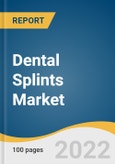This has given way to growth in the global dental splints market. Furthermore, health care professionals are working together in tandem to provide integrated medical, oral, and behavioral health care in community health centers, schools, medical care settings, nursing homes, as well as in dental clinics. They are also trying to improve access to care by creating a more qualified and diverse oral healthcare manpower, expanding insurance coverage, addressing the growing expense of dental qualification, and improving the overall affordability of oral care.
The prevalence rate of TMJ, temporomandibular joint, and muscle disorder is between 5-12%. Uncommon for chronic pain, the prevalence rate of TMJ disease is higher among younger individuals. TMJ disorders are more common in women compared to men, and women using either oral contraceptives or supplemental estrogen are more likely to seek treatment for these TMJ conditions. Millions of individuals globally suffer from temporomandibular joint disorders (TMJ) which are characterized by joint dysfunction and pain. TMJ (ID), internal derangement is the most prevalent kind of Temporomandibular Disorder (TMDs), including 41.1% of patients with TMD. The TMJ condition affects an estimated 10 million Americans, roughly between the ages of 20 and 40 years old-and now those numbers are further growing.
The pandemic has resulted in reduced demand for dental products and equipment which had also impacted the new investment in dental education and the dental healthcare industry. Oral care products such as dental splints, mouth guards, etc. have also faced a low-level of sales and revenue in the first half of 2020 due to the disrupted supply chain of the product and lockdown restrictions in the country. However, in 2021, the market grew at a significant rate due to the covid-19 related stress disorder. COVID-19 outbreak had affected almost every facet of our living hood, and dentistry is no exception. Since stress is one of the leading causes of bruxism, it’s not shocking that it has been on the rise over the last two years. Since the start of the COVID-19 pandemic, it has been noted by the majority of dental practitioners that stress-related oral health disorders have dramatically increased. This has had a favorable effect on the dental splint market in 2021.
Dental Splints Market Report Highlights
- The rigid segment dominated the market in 2021. This is because rigid dental splints are more prominent in the market, for instance, Oral-B Nighttime Dental Guard by P&G. Hence, the presence of a major share of the rigid splints, makes it a dominant segment
- The offline (through dental professionals) segment is expected to witness a significant CAGR of 5.4% during the forecast period. The dominance of the segment is due to the preference of patients to get recommendations from dentists and buy the products. However, online sale is becoming very popular as many companies are offering direct online sale to their customers, hence likely to grow at a faster rate
- North America dominated the market in 2021 and accounted for revenue share of 37.8%, owing to the increase in the U.S. population, mainly the aging segment; technological advances in dentistry; and the increasing coverage by dental insurance plans
- Asia Pacific is likely to have the highest CAGR during the forecast period due to the growing patient population, and rising government initiatives and awareness about oral health
Table of Contents
Companies Mentioned
- Aqualizer
- Sentinel Mouth Guards
- Glidewell
- Procter & Gamble
- Dentek
- Brux Nightguard
- Sporting Smiles
- Smile Brilliant
- Chomper Labs
Table Information
| Report Attribute | Details |
|---|---|
| No. of Pages | 100 |
| Published | October 2022 |
| Forecast Period | 2022 - 2030 |
| Estimated Market Value ( USD | $ 437.1 Million |
| Forecasted Market Value ( USD | $ 693 Million |
| Compound Annual Growth Rate | 5.9% |
| Regions Covered | Global |
| No. of Companies Mentioned | 9 |









